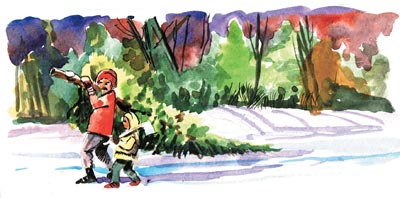Enjoy an old holiday tradition by cutting your own Christmas tree

For most Americans, the traditional trek to the woods to find the family’s holiday tree exists only on nostalgic Christmas cards and December calendar pages. The closest most urban Americans come to that festive family expedition is a trip to the temporarily forested tree lots that spring up seasonally. The tradition survives today in areas where private tree plantations allow cutting and on portions of forested public lands, principally in the West, where tree cutters pay a small fee for a limited number of permits.
Since all forested areas in Clark County remain closed to tree cutting, Southern Nevadans desiring to continue this holiday outing must drive a few hours. The closest cutting areas on public lands lie in Lincoln, Esmeralda and Nye counties in Nevada and in Southern Utah near St. George and Cedar City. Officials of the Bureau of Land Management and the USDA Forest Service designate different cutting areas each year for the good of the forests.
Earlier in the fall, tree cutters could apply for tree permits through the mail. Now, they obtain permits in person in the area where they plan to cut. Visit the Humboldt-Toiyabe National Forest’s Tonopah ranger district office or the neighboring BLM field office on U.S. 95 approaching Tonopah for permits in Central Nevada. The BLM’s Caliente field office offers up to 5,000 tree permits in Lincoln County. The office on U.S. 93 as you enter Caliente remains open weekdays from 7:30 a.m. to 4:30 p.m. and on the first three Saturdays in December. For more information, contact the field office at (775) 726-8100.
The Interagency office in St. George, Utah, handles both BLM and Dixie National Forest tree permits. Turn right at the Bluff Street exit to find the building at 345 E. Riverside Drive. Obtain permits weekdays from 8 a.m. to 5 p.m. and on Saturday from 10 a.m. until 3 p.m. Additionally, permits are available at the Veyo Mercantile on Highway 18. The Cedar City office of Dixie National Forest, 1789 N. Wedgewood Lane, plans extended hours during the season. Call the St. George office at (435) 688-3246 or the Cedar City office at (435) 865-3700.
Permit costs vary, but remain a bargain. BLM permits cost $3 in Nevada and $5 in Utah. Forest Service permits cost as little as $5 or as much as $10. Be prepared to pay by cash or check. No credit card transactions, please. One person may purchase up to five tags, but most provide the names and addresses of all the people for whom the tags are intended. Tags must be affixed to trees when cut. A single vehicle may carry as many as five trees. More than five trees requires a shipping permit.
Agencies hand out cutting area maps and information on cutting and care of the trees. Tree cutters learn about types of trees available. On BLM lands, only pinyons and junipers, commonly called cedars, may be cut. Pinyons, junipers and certain types of firs or pines may be available in the national forest cutting areas. Whether you use an ax, saw or chain saw, make sure your equipment is sharp and in good repair. Cut your tree to leave a stump of less than six inches.
Be prepared for this adventure. Expect colder temperatures, even snow and ice. Only rough roads access some cutting areas, making the family sedan a poor choice of vehicle. Your search for the perfect tree may take you some distance from your vehicle on foot, so dress in warm layers, wear sturdy footgear and keep an eye on landmarks. Pack picnic provisions that include drinking water and warm beverages, as well as hearty fare like hot soup or chili.
The tree you cut yourself will be the freshest tree you’ll ever decorate. Keep it that way with good care. When you get home, wash the tree down with the garden hose. Re-cut its base and immediately stand it in a large container of water. Store it in the shade until you bring it indoors. Choose a heavy tree holder.
Save floors from sap, pine needles and drips by setting the tree up on top of a plastic tarp. This makes maneuvering the tree into position much easier. Conceal the tarp under a tree skirt or white sheet. When taking down the tree, spread the tarp out to catch falling needles and wrap it around the tree before sliding it out the door.
Margo Bartlett Pesek’s column appears on Sundays.